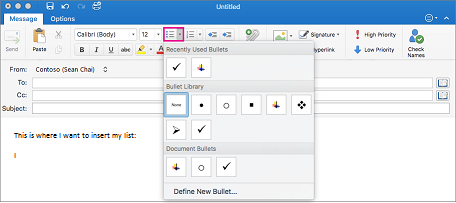Outlook 2016 For Mac Conditional Formatting
Excel for Office 365 for Mac Excel 2019 for Mac Excel 2016 for Mac Conditional formatting quickly highlights important information in a spreadsheet. But sometimes the built-in formatting rules don’t go quite far enough. Adding your own formula to a conditional formatting rule gives it a power boost to help you do things the built-in rules can’t do.
You may want to create a rule in Outlook 2016 for Mac to help you stay organized with your emails. Kindly visit this link to know more about creating a rule in Outlook 2016 for Mac. We also have released an article that discusses how to format email messages. In this course, I'll show you keystroke shortcuts to format numeric cells, how to use conditional formatting to apply formats dynamically, the most efficient ways to copy formats quickly, and numerous features that add flare and visual interest to your worksheets.
For example, let’s say you track your dental patients’ birthdays to see whose is coming up and then mark them as having received a Happy Birthday greeting from you. In this worksheet, we see the information we want by using conditional formatting, driven by two rules that each contain a formula. The first rule, in column A, formats future birthdays, and the rule in column C formats cells as soon as “Y” is entered, indicating that the birthday greeting has been sent.
To create the first rule: • Select cells A2 through A7. Do this by dragging from A2 to A7. • On the Home tab, click Conditional Formatting > New Rule.

• In the Style box, click Classic. • Under the Classic box, click to select Format only top or bottom ranked values, and change it to Use a formula to determine which cells to format. • In the next box, type the formula: =A2>TODAY() The formula uses the TODAY function to see if the dates in column A are greater than today (in the future). If so, the cells are formatted.
• On the Format with box, click custom format. • In the Format Cells dialog box, click the Font tab. • In the Color box, select Red. In the Font style box, select Bold.  • Click OK until the dialog boxes are closed.
• Click OK until the dialog boxes are closed.
The formatting is applied to column A. To create the second rule: • Select cells C2 through C7. • On the Home tab, click Conditional Formatting > New Rule. • In the Style box, click Classic. • Under the Classic box, click to select Format only top or bottom ranked values, and change it to Use a formula to determine which cells to format.
Outlook 2016 For Mac Download
• In the next box, type the formula: =C2='Y' The formula tests to see if the cells in column C contain “Y” (the quotation marks around the Y tell Excel that this is text). If so, the cells are formatted.
• On the Format with box, click custom format. • At the top, click the Font tab.
• In the Color box, select White. In the Font Style box, select Bold. • At the top, click the Fill tab, and then for Background color, select Green. • Click OK until the dialog boxes are closed. The formatting is applied to column C. Try it out In the examples above, we used very simple formulas for conditional formatting.